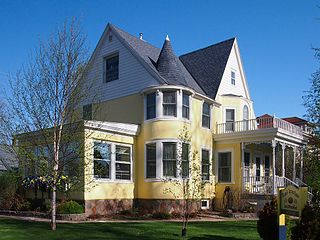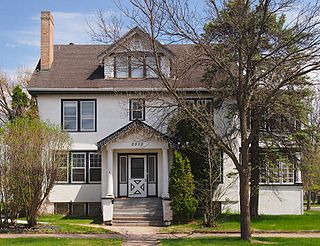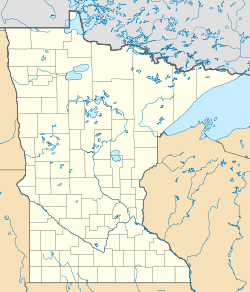
The Mesabi Iron Range is a mining district and mountain range in northeastern Minnesota following an elongate trend containing large deposits of iron ore. It is the largest of four major iron ranges in the region collectively known as the Iron Range of Minnesota. First described in 1866, it is the chief iron ore mining district in the United States. The district is located largely in Itasca and Saint Louis counties. It has been extensively worked since 1892, and has seen a transition from high-grade direct shipping ores through gravity concentrates to the current industry exclusively producing iron ore (taconite) pellets. Production has been dominantly controlled by vertically integrated steelmakers since 1901, and therefore is dictated largely by US ironmaking capacity and demand.

This is a list of the National Register of Historic Places listings in Houghton County, Michigan.

The Lake Vermilion-Soudan Underground Mine State Park is a Minnesota state park at the site of the Soudan Underground Mine, on the south shore of Lake Vermilion, in the Vermilion Range (Minnesota). The mine is known as Minnesota's oldest, deepest, and richest iron mine. It formerly hosted the Soudan Underground Laboratory. As the Soudan Iron Mine, it has been designated a U.S. National Historic Landmark.

The Hull–Rust–Mahoning Open Pit Iron Mine in Hibbing, Minnesota, United States, is the largest operating open-pit iron mine in Minnesota. The pit stretches more than three miles (5 km) long, two miles (3 km) wide, and 535 feet (163 m) deep. It was established in 1895 and was one of the world's first mechanized open-pit mines.

This is a list of the National Register of Historic Places listings in Rice County, Minnesota. It is intended to be a complete list of the properties and districts on the National Register of Historic Places in Rice County, Minnesota, United States. The locations of National Register properties and districts for which the latitude and longitude coordinates are included below, may be seen in an online map.

Manganese is a ghost town and former mining community in the U.S. state of Minnesota that was inhabited between 1912 and 1960. It was built in Crow Wing County on the Cuyuna Iron Range in sections 23 and 28 of Wolford Township, about 2 miles (3 km) north of Trommald, Minnesota. After its formal dissolution, Manganese was absorbed by Wolford Township; the former town site is located between Coles Lake and Flynn Lake. First appearing in the U.S. Census of 1920 with an already dwindling population of 183, the village was abandoned by 1960.

This is a list of the National Register of Historic Places listings in Saint Louis County, Minnesota. It is intended to be a complete list of the properties and districts on the National Register of Historic Places in Saint Louis County, Minnesota, United States. The locations of National Register properties and districts for which the latitude and longitude coordinates are included below, may be seen in an online map.

This is a list of the National Register of Historic Places listings in Stearns County, Minnesota. It is intended to be a complete list of the properties and districts on the National Register of Historic Places in Stearns County, Minnesota, United States. The locations of National Register properties and districts for which the latitude and longitude coordinates are included below, may be seen in an online map.

This is a list of the National Register of Historic Places listings in Itasca County, Minnesota. It is intended to be a complete list of the properties and districts on the National Register of Historic Places in Itasca County, Minnesota, United States. The locations of National Register properties and districts for which the latitude and longitude coordinates are included below, may be seen in an online map.

This is a list of the National Register of Historic Places listings in Lake County, Minnesota. It is intended to be a complete list of the properties and districts on the National Register of Historic Places in Lake County, Minnesota, United States. The locations of National Register properties and districts for which the latitude and longitude coordinates are included below, may be seen in an online map.

The Calumet Historic District is a National Historic Landmark District that encompasses most of the village of Calumet, Michigan. The district was designated in 1989 for the community's importance in the history of the region's copper mining industry.

This is a list of the National Register of Historic Places listings in Lac qui Parle County, Minnesota. It is intended to be a complete list of the properties and districts on the National Register of Historic Places in Lac qui Parle County, Minnesota, United States. The locations of National Register properties and districts for which the latitude and longitude coordinates are included below, may be seen in an online map.

Hibbing High School is a public school, grades 7–12, in Hibbing, Minnesota, United States. It was built from 1920 to 1922 as the entire city relocated two miles (3 km) south to make way for the expanding Hull–Rust–Mahoning Mine. The lavish Tudor Revival building was constructed at a cost of about $3.9 million, becoming known as the "castle in the woods" and—thanks to its polished brass fixtures—the "school with the golden doorknobs". The project was bankrolled by the mining industry, which wanted to make the move more palatable for those being displaced. It also satisfied immigrants' desire for their children's education.

The Milford Mine produced high manganese-content iron ore in Wolford Township, Minnesota, United States. On February 5, 1924, it was the site of the Milford Mine Disaster, the worst mining accident in Minnesota history, when it was flooded by water from a nearby lake, killing 41 miners. Only seven men were able to climb to safety. Starting in 2010, the site has been under development by Crow Wing County as Milford Mine Memorial Park. The property was listed as the Milford Mine Historic District on the National Register of Historic Places in 2011 for its state-level significance in the themes of industry and historical archaeology. It was nominated for its association with a significant event in Minnesota history, and for potential archaeological resources that could illuminate mining technology, the rise and fall of iron-ore mining on the Cuyuna Range, and the daily lives of its workers.

The East Second Street Commercial Historic District is a small historic district in Winona, Minnesota, United States. It comprises 14 contributing properties mostly built in the late 1860s. The district was listed on the National Register of Historic Places in 1991 for its state-level significance in the themes of architecture and commerce. It was nominated for being one of the few surviving remnants of the original business district of a Minnesota river town, and for being a symbol of Winona's swift growth as a lumber and grain trade center.

The Mitchell–Tappan House is a historic house in Hibbing, Minnesota, United States. It was built in 1897 as a residence for executives of the Oliver Mining Company. The house was listed on the National Register of Historic Places in 1980 for its local significance in the themes of architecture and social history. It was nominated for reflecting the sumptuous lifestyle enjoyed by an elite few in the early mining era.

The Delvic Building is a historic commercial building in Hibbing, Minnesota, United States. It was constructed in 1922 when Hibbing was a company town for a subsidiary of U.S. Steel, which took the unusual step of designing the commercial as well as residential sectors. In previous company towns, such as Coleraine, Minnesota, or Gary, Indiana, the controlling industry focused on employee housing and left commercial development to private entrepreneurs. The Delvic Building was listed on the National Register of Historic Places for its local significance in the themes of commerce, community planning and development, and industry. It was nominated for exemplifying the type of building constructed in Hibbing's planned downtown, and for attesting to this evolution in corporate control of community development.

The Emmett Butler House is a historic house in Hibbing, Minnesota, United States. It was built in a simplified Colonial Revival mode in 1916 for Emmett Butler, a local leader and an executive in Minnesota's influential Butler Brothers Construction Company. The house was listed on the National Register of Historic Places in 1980 for its local significance in the themes of architecture and industry. It was nominated as an example of the Colonial Revival houses built in Minnesota in the early 20th century and for its associations with Butler.

The Androy Hotel is a former hotel building in Hibbing, Minnesota, United States. It was built in 1921 by the Oliver Iron Mining Company to anchor the city's new business district, which was being relocated so the Hull–Rust–Mahoning Open Pit Iron Mine could expand. The Androy Hotel was listed on the National Register of Historic Places in 1986 for its local significance in the themes of architecture and industry. It was nominated for being a good example of a large, Renaissance Revival hotel built to serve a growing mining community. When the East Howard Street Commercial Historic District was designated in 1993, the Androy Hotel was listed as a contributing property.

The Andrew G. Anderson House is a historic house in Hibbing, Minnesota, United States. It was built in 1920 for Andrew "Bus Andy" Anderson, a pioneer in the intercity bus service industry. The house was listed on the National Register of Historic Places in 1980 for its local significance in the themes of architecture and transportation. It was nominated for its association with Anderson and its status as one of the most lavish residences in the Hibbing area.
























